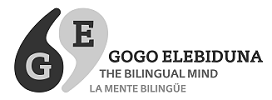Can the native language be forgotten?
Authors: Noèlia Sanahuja, PhD candidate at the Dept. of Linguistics and Basque Studies (UPV/EHU) and Luis Pastor, Lecturer at the Dept. of Didactics of Language and Literature (UPV/EHU). Both belong to The Bilingual Mind research group.


The acquisition of the native language (L1) is fast and unconscious. By the time children are 4-5 years old, their competence in the L1 is already adult-like (Aparici & Igualada, 2019). One of the underlying factors of this competence is linguistic exposure, since children constantly listen to their caretakers speak the native language. Another factor determining proficiency in the L1 is age of acquisition. The later a learner is exposed to the L1, the more likely it is that there are deficits in the mastery of its phonology and syntax (Pallier et al. 1997). Lenneberg (1967) suggested that there is an optimal period of time to acquire the native language (the critical period, up to 12 years). If a child is not exposed to a language during that time, s/he will never reach full competence in any language. An example of this is Genie, an American girl who was locked in her bedroom until she was 13 years old and received no linguistic input during this time. When she was liberated, Genie could not understand or speak English. The linguist Susan Curtiss helped Genie learn the language, but she was only capable of learning some words and grammatical structures. Her linguistic competence was like that of a 2-year-old (Curtiss, 1977).
A time to acquire the native language
The critical period has also been applied to second language acquisition. If a second language (L2) is learnt within this period, native-like competence can be achieved. If, by contrast, the L2 is learnt after the critical period, its mastery will be reduced (Johnson & Newport, 1989). In addition, even within the critical period, some learners do not reach full proficiency in the L2 (Weber-Fox & Neville, 1996; Pallier et al. 1997). This has been attributed to the fact that, since the native language is the first language learnt, learners’ brains become tuned to that language, losing the plasticity necessary to completely master another language (Lenneberg, 1967; Flege et al., 1999). On most occasions, the L1 is the dominant language, i.e., the most used language from birth. The L2 is usually learnt a few years later (for instance, when starting school) and is used less frequently. However, in some cases, the L2 becomes the dominant language and the frequency of use of the L1 diminishes or even stops. This would be the case of children adopted by families from other countries in the first years of their lives. When this occurs, does the L2 replace the L1, to the point that it is forgotten? Or do learners keep some unconscious knowledge of their native language?
The two most influential studies investigating this were Pallier et al. (2003) and Ventureyra et al. (2004). Pallier and colleagues conducted a study with adult Koreans adopted by French families when they were between 3 and 8 years old. These adoptees had stopped using their L1 when they were adopted and reported having forgotten it. To investigate whether Korean was still present in the brains of these adoptees, these speakers performed three tasks. Additionally, there was a control group of French natives without knowledge of Korean. In the first task, the two groups listened to sentences in Korean and four other languages and had to indicate, on a scale from 1 to 7, how confident they were that a sentence was in Korean. Upon listening to a Korean sentence, the French and the Korean reported being not confident at all that the sentence was in that language. In the second task, the two groups of participants read a French word and listened to two words in Korean. They had to indicate which of the two Korean words was the translation of the French word.Neither the French nor the Korean could identify the Korean translations. In the last task, Pallier et al. investigated the brain activity of the two groups of speakers while listening to sentences in French, Korean, Polish and Japanese using functional magnetic resonance imaging. This technique detects increases in blood flow in areas of the brain, which indicates that an area is being used. Participants listened to each sentence and then listened to a fragment. Their task was to indicate whether the fragment was part of the sentence or not. Brain activity did not differ when Koreans listened to Korean compared to the two languages they had never been exposed to. The brain regions that activated when listening to French were similar for French natives and Korean natives.
Traces in the brain
Ventureyra et al. (2004) investigated whether there were more subtle traces of the native language in participants’ brains. Their focus was on whether adult Korean natives adopted by French families during childhood could perceive the difference between three types of /k/ or /p/ sounds and two types of /s/ sounds existing only in Korean. Half of the adoptees participating in the study had been reexposed to Korean after adoption. A group of French natives and a group of Korean natives (not adopted) also participated. Ventureyra et al. invented pairs of words (consonant-vowel-consonant-vowel) which looked like Korean words but had no real meaning (pseudowords). The two words of a pair could be identical or differ in either the first vowel or the first consonant (for instance, two different Korean /k/, /p/ or /s/ sounds). The three groups of participants listened to the pairs of pseudowords and had to indicate whether they had listened to the same word or to two different words. The French natives and the Korean adoptees could not perceive the difference between the pairs of Korean consonants. By contrast, the group of Korean natives who had not been adopted could perceive the consonant contrasts. The group of Korean adoptees who had been reexposed to Korean could perceive one of the contrasts.
From these studies, the authors concluded that, generally speaking, there was no evidence that the native language had left traces in the brains of Korean adoptees. Since participants had been adopted in the first years of life, they could acquire the second language fully, as if it was the native language. This goes in line with the hypothesis that learners’ brains are still plastic within the critical period and that the L2 can replace the L1. Finally, it is not clear whether, in the studies presented, the native language had been forgotten or whether it was present, but extremely difficult to recover. The findings from Ventureyra et al. indicating that subjects reexposed to Korean could perceive some Korean consonants suggest that contact with the L1 might facilitate its recovery. Additional evidence comes from other studies (Montrul, 2011, 2013; Hyltenstam et al., 2009; Oh et al., 2010). For example, Hyltenstam et al. and Oh et al. observed that Koreans adopted between 1-9 years old, who currently did not speak Korean but had been reexposed to the language in high school or college, showed an ability to discriminate Korean consonant contrasts similar to that of Korean monolinguals.
In sum, this article shows that age of exposure is a crucial factor in learning and maintaining one’s native language. If speakers are not exposed to their L1 during the critical period, this may not develop fully (as in the case of Genie) or an L2 may take its place (as in the case of adopted children).
References
Aparici, M. & Igualada, A. (2019). El desarrollo del lenguaje y la comunicación en la infancia. Editorial UOC.
Curtiss, S. (1977). Genie: A Psycholinguistic Study of a Modern-Day “Wild Child”. Academic Press.
Flege, J. E., Yeni-Komshian, G. H., & Liu, S. (1999). Age constraints on second-language acquisition. Journal of Memory and Language, 41(1), 78-104. https://doi.org/10.1006/jmla.1999.2638
Hyltenstam, K., Bylund, E., Abrahamsson, N., & Park, H. (2009). Dominant-language replacement: The case of international adoptees. Bilingualism: Language and Cognition, 12(2), 121-140. https://doi.org/10.1017/S1366728908004008
Johnson, J. S., & Newport, E. L. (1989). Critical period effects in second language learning: The influence of maturational state on the acquisition of English as a second language. Cognitive Psychology, 21(1), 60–99. https://doi.org/10.1016/0010-0285(89)90003-0
Lenneberg, E. (1967) Biological Foundations of Language. John Wiley and Sons.
Montrul, S. A. (2011). First language retention and attrition in an adult Guatemalan adoptee. Language, Interaction and Acquisition, 2(2), 276-311. https://doi.org/10.1075/lia.2.2.05mon
Montrul, S. A. (2013). First language retention and attrition in an adult Guatemalan adoptee. En M. S. Schmid & B. Köpke (Eds.), Benjamins Current Topics (Vol. 48, pp. 91-126). John Benjamins Publishing Company. https://doi.org/10.1075/bct.48.05mon
Oh, J. S., Au, T. K.-F., & Jun, S.-A. (2010). Early childhood language memory in the speech perception of international adoptees. Journal of Child Language, 37(5), 1123-1132. https://doi.org/10.1017/S0305000909990286
Pallier, C., Bosch, L., & Sebastián-Gallés, N. (1997). A limit on behavioral plasticity in speech perception. Cognition, 64(3), B9-B17. https://doi.org/10.1016/S0010-0277(97)00030-9
Pallier, C., Dehaene, S., Poline, J. B., LeBihan, D., Argenti, A. M., Dupoux, E., & Mehler, J. (2003). Brain imaging of language plasticity in adopted adults: Can a second language replace the first? Cerebral Cortex, 13(2), 155-161. https://doi.org/10.1093/cercor/13.2.155
Ventureyra, V. A. G., Pallier, C., & Yoo, H.Y. (2004). The loss of first language phonetic perception in adopted Koreans. Journal of Neurolinguistics, 17(1), 79-91. https://doi.org/10.1016/S0911-6044(03)00053-8
Weber-Fox, C. M., & Neville, H. J. (1996). Maturational constraints on functional specializations for language processing: Erp and behavioral evidence in bilingual speakers. Journal of Cognitive Neuroscience, 8(3), 231-256. https://doi.org/10.1162/jocn.1996.8.3.231
More on the subject:
Mandela was right: the Foreign Language Effect
How do bilinguals control their languages?